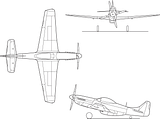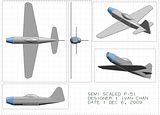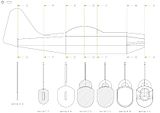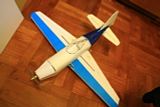Drawing Board
I have always wanted to build a scaled model of a classic war bird. One of the WWII planes that I really love is of course the famous P-51 Mustang.



[1st] A P-51 3Views Drawing Found on Google
[2nd] Virtual 3-D Model of the P-51 I Desgined
[3rd] Corss Section Drawing of the P-51 Plans
By studying some of the 3 view-drawings and pictures on Google, I made myself a scaled down P-51 plans in Solid Works NX. I created a 3-D sclaed down model of the P-51 in NX whcih I then turned it into a set of 1:1 plans that I could printed out and follow. With the plans being done, I started the actual contrstuion works.
Construction
I’ve chosen 4mm foam for constructing the wings and most part of the fuselage. However, the tail part of the fuselage (the blue part of the aircraft) is build with wooden straws and covered with heat-shrink coverings for weight saving. A 2mm carbon fiber rod is also hot glued onto the wing for reinforcement. Noted the wing features a KF Airfoil. This is the first time that I’ve ever attempted to use KF airfoil for my RC plane. A 6x4 propeller is used and a 3 cell 11.1v 1200mah Li-po battery is used.
Test Flying
Ground testing shows that the power unit do creates quite some serious thrust. However the P-51 seems to be incredibly unstable on pitch during the first flight. I could hardly maintain a level flight. I thought the aircraft was being tail too heavy so after landing it I moved the C.G forward. It doesn’t seem to help at all. I suspect that the wing loading of this aircraft is a little too heavy and the tail wing is built too small. As a result, the main wing is always at the edge of stalling while the small tail plane is unable to provide sufficient horizontal stability.

Even though the P-51 doesn’t turn out to be a great flying machine, I did gain valuable experience in creating my own plans using Solid Works NX. It is so much fun seeing something that's on a blueprint turnning in to a real flying mechine. 


















